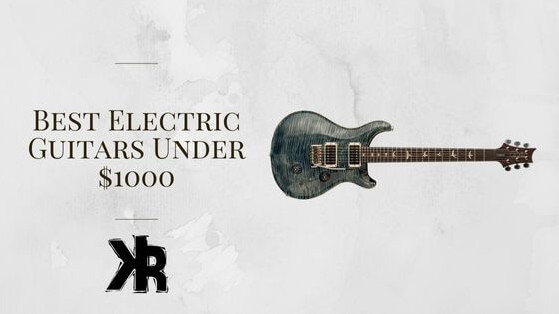Table of Contents
Maybe you are upgrading, or perhaps just getting started. At any rate, a guitar under 1000 dollars will surely be a benefit to your experience as a player.
The instruments in this price range are aimed more at professionals, so the features and quality are quite good!
My list of the best electric guitars under $1000 has been constructed by testing and playing them. I watch what manufacturers have released and see how players respond. If they seem to have hype, I test them and update the list if they make the cut.
As an expert guitar player, I hope my comparison will help you find the perfect instrument to suit your budget, style, and skill level. Now, let’s get started!
My Top Choice
PRS SE Custom 24-08
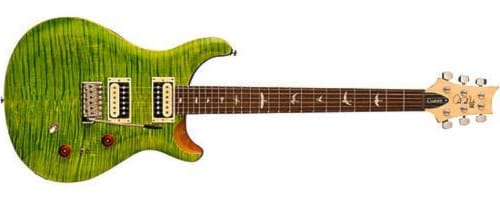
Summary
The sounds available from this guitar are incredibly versatile. The way the electronics are designed, allow for an incredible range of tones. Plus, the playability is just next level, which makes this one of my favorite guitars!
Next Best
Epiphone Les Paul Standard
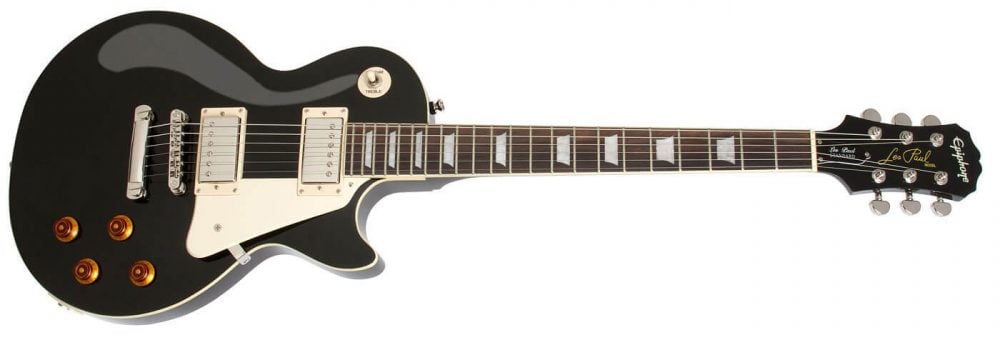
Summary
Another amazing guitar with wicked tone and feel. Epiphone makes great Gibson models that play and sound great. This too is a great value for money if you’re looking for Les Paul tones!
Squier 40th Anniversary Gold Edition Telecaster
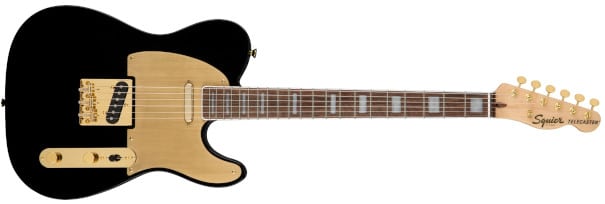
Summary
If you like vintage tones, a Telecaster is your best bet! This Squier anniversary series has all the great twang and playability you could want from a Telecaster! Plus, it looks incredible and is a great buy!
Best Electric Guitars Under $1000
Some of these brands might be familiar to you. They are practically household names. These are manufactures who consistently make excellent guitars on a regular basis.
And so I was able to compile a list of the best guitars on the market! My top pick is the PRS SE Custom 24-08, followed by the Epiphone Les Paul Standard. I chose them because they sound great and are incredibly versatile.
But there are many more on my list! So let’s take a look at what I feel are the hottest guitars under $1000 today!
PRS SE Custom 24-08
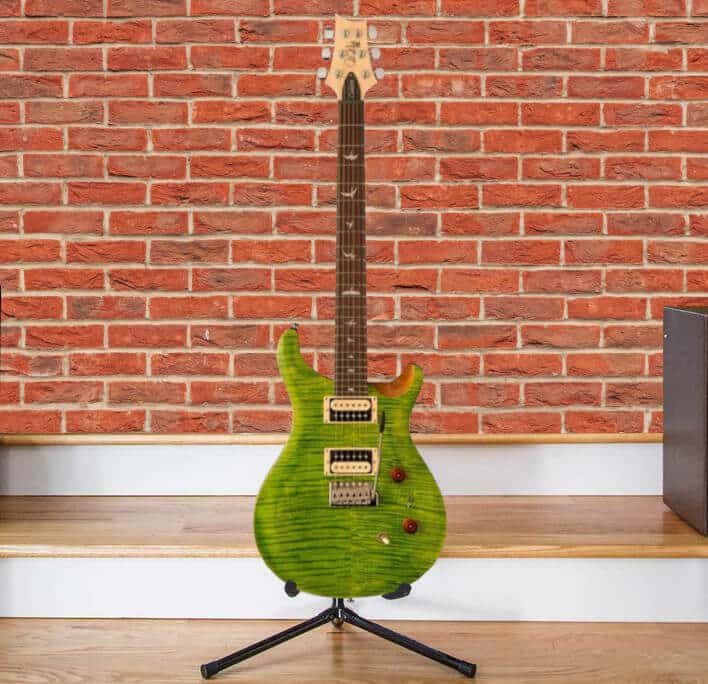
The new revision in the SE Custom line is the 24-08. An already awesome guitar design made more versatile with 8 pickup positions and tons of tone!
Improving upon a great model better can be tricky if you are not PRS. They have taken a workhorse and upgraded it to be unbelievable. It has many pickup tones from single coil to humbucker. Thanks to the coil tap electronics.
The switching is very intuitive and high quality. The sounds are simply wonderful and more refined compared to other revisions.
The exceptional build quality and electronics give this guitar an excellent feel! It can cover many bases and is better than a lot of others worth far more money. You really cannot go wrong!
Features
- PRS warranty: 5 year.
- Mahogany body.
- 24 Frets.
- Wide-thin neck.
- TCI pickups.
- 8 pickup combinations.
Score
SE Custom 24-08 Score
Overall
-
Build Quality
-
Sounds
-
Playability
-
Appearance
Build Quality
One thing that I love about PRS guitars is the quality. They make guitars like no one else! This Custom 24 variation is part of their SE line, but man is it good! The body is beautiful with nice contouring around the edges. The hardware robust and very functional!
The electronics are installed with some quality soldering and wiring work. The quality control is always high with PRS instruments. All around, it’s just an excellent guitar, and I’m super impressed!
Sound Performance
This guitar has 8 settings that each have their own tone. You can find some bright single-coil tones in one configuration, then warm, silky smooth sounds in another. The single coil tones really stood out to me, it almost felt like I was playing a Stratocaster.
On the other end of the spectrum, the hard rock humbucker sounds were also on point. The guitar comes with 9–42 strings, so they are easy to play and do provide a heavy sound should you desire it. This is an excellent guitar and easily one of my favorites.
Cost and Value
The PRS Custom 24-08 is available in a few different colors, but the price of them is $949.00. They all come with the same great hardware and sound. They are an excellent value and a guitar you will use for many years.
And because they are made by PRS, they won’t lose their value. They will always be sought after by many players.
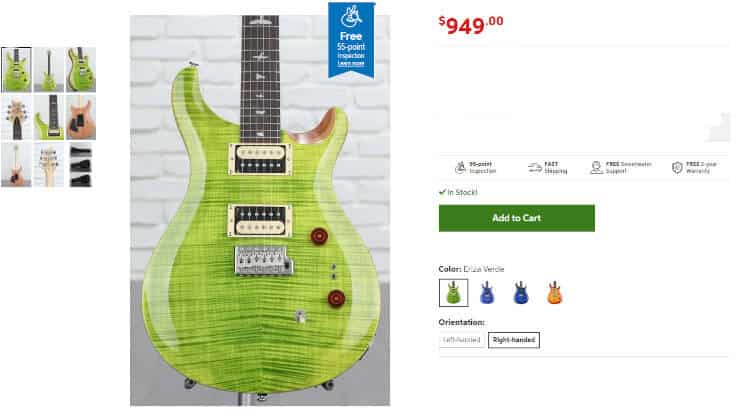
PROS
- Great construction and quality.
- 8 Pickup positions.
- Fluid neck.
- Great pick attack.
- Musically versatile.
CONS
- Slightly thin veneer top.
Epiphone Les Paul Standard
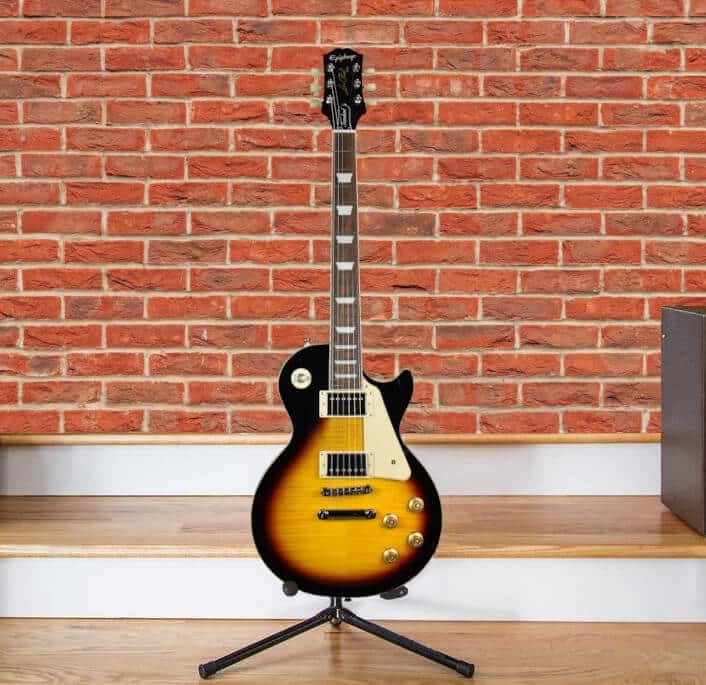
The Les Paul guitar has a legacy that is known for rock and roll. This version made by Epiphone gives players of all different skill levels the ability to afford one. Anyone from blues to hard rock players can now get the legendary tone in a quality made guitar.
Features
- Epiphone warranty: 2 year.
- Mahogany body.
- 22 Frets.
- Mahogany neck.
- Alnico classic humbuckers.
- D style neck taper.
Score
Build Quality
The pickups and hardware are all quality, loaded into a mahogany body with a one piece design. The neck is a through-body construction, making it very rigid but also providing a feel that is dynamic.
There are also many different colors to choose from that make this not only a great sounding electric guitar, but a beautiful one as well. The tuners are rigid and feel good when turned. Plus, they hold tune well and didn’t slip at all while I played it.
Sound Performance
The alnico humbuckers in this guitar don’t have an overly high output. But they do provide a good rock tone that is very thick. The clarity is also nice, they are not overly dark sounding.
When set to the neck pickup, I was able to get a great blues tone that was warm. Especially when I lowered the volume control for the pickup.
The leads and solos rip with this guitar! It has all the frequencies and sustain you could want. It does have enough output to push an amp pretty hard, which was also nice. Crunchy hard rock tones had a throaty sound which is perfect. It’s one of my favorite sounds.
The video below is a great showcase of all the sounds possible with this guitar. Have a listen to get a better idea of what it’s capable of.
Cost and Value
You can find this guitar in a few different models. There are many colors and pickup options.
As a result, it can range from $650.00 to $1000.00 which is quite incredible! The quality of the guitars is right up there with some premium options. Epiphone has out done themselves!
This means that it’s an excellent value for the money! The sound, aesthetics and build are all top shelf! These guitars will retain their value for years, which makes them a wonderful investment.
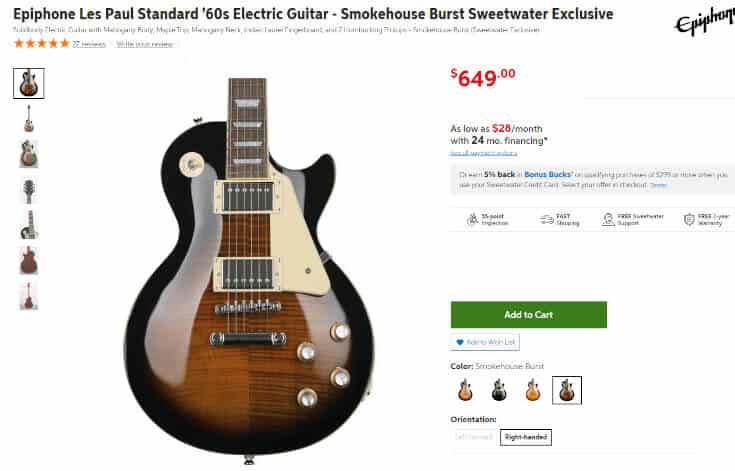
PROS
- Quality materials and design.
- Nice, warm sound.
- Feels good to play.
- Quality pick-ups and hardware.
- Many different colors to choose from.
CONS
- A set-up may be required out of the box.
- Some have reported quality issues.
Squier 40th Anniversary Gold Edition Telecaster
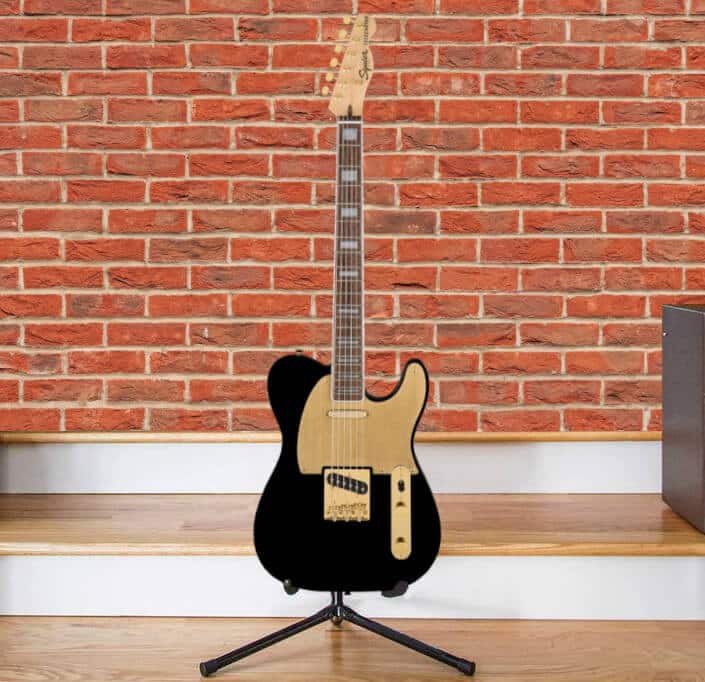
Features
- Gold anodized aluminum pickguard.
- Vintage-style ’50s Telecaster pickups.
- Modern C-shaped maple neck with 9.5″ radius fingerboard.
- Vintage-style string-through-body bridge with brass barrel saddles.
- 21 medium jumbo frets.
Build Quality
The Squier 40th Anniversary Gold Edition Telecaster boasts impressive build quality for its price range. The gold anodized aluminum pickguard not only looks stunning, but also adds a layer of durability.
Having played this Telecaster model myself, I can attest to its solid feel and attention to detail. The maple neck and Indian Laurel fingerboard contribute to the overall sturdiness. All while the vintage-style bridge ensures stable tuning.
Sound Performance
This Telecaster produces the classic twang we all know and love. I’ve had the opportunity to play this model with a band, and it delivers a bright, clear sound with plenty of character.
The vintage-style ’50s Telecaster pickups contribute to its authentic tone. Offering a well-balanced mix of warmth and bite.
Playability
The modern C-shaped maple neck on this Telecaster is comfortable and easy to play, even for extended periods. I’ve found it to be particularly accommodating for players with smaller hands.
The 9.5″ radius fingerboard facilitates effortless string bending, and the 21 medium jumbo frets provide ample space for a wide range of playing styles.
Cost and Value
The Squier Gold Edition Telecaster offers an excellent balance between quality and affordability. For $499.99, you get a well-crafted instrument with iconic Telecaster sound and playability.
This is an exceptional choice for beginners looking to invest in their first electric guitar. But also for seasoned players seeking a reliable and visually striking addition to their collection.

PROS
- Eye-catching gold anodized pickguard.
- Classic Telecaster sound.
- Comfortable modern C-shaped neck.
- Good value for money.
- Versatile for various playing styles.
CONS
- May require a professional setup for optimal playability
- No hard shell case or gig bag included.
PRS SE Custom 24
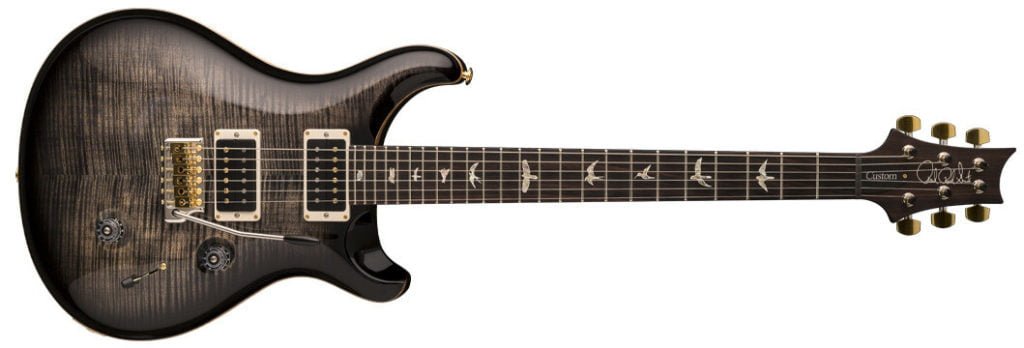
The PRS SE Custom 24 is a beautiful guitar and sounds fantastic! Players from all around will be asking about the amazing tone once they hear it!
This mahogany body with a maple top has a rich mid-range and bright snap from the PRS custom humbuckers. The wide-thin neck is incredibly comfortable. It’s easy to play, especially with the cutaway in the body.
You can be proud to own it and will have trouble it putting down. The pull pot allows for humbucker and single coil tones. The PRS-designed tremolo gives this guitar the versatility that modern players want!
Features
- PRS warranty: 5 year.
- Mahogany body.
- 24 Frets.
- Wide-thin neck.
- PRS Custom pickups.
Score
Build Quality
I’m not sure how PRS does it, especially with these guitars made overseas. But the quality is exceptional. This was the first PRS guitar that I had ever played, and I fell in love with it immediately. The body contouring alone from a guitar at this price was nice to see.
The choice of wood used, and the above average hardware, is just remarkable. The bridge and tuners are of excellent quality. They feel perfect when used and perform reliably.
There is a reason why PRS is held in such high esteem in the guitar world. The amazing build quality is only half of it.
Sound Performance
The PRS SE Custom 24 is a good-sounding guitar. The pickups are warm and articulate. They have a good mid-range focus. This makes them very throaty sounding under high gain.
For leads, this is a good tone as it is full and responsive. For rhythm, it’s thick and deep for great foundational parts.
I am a big fan of PRS guitars and the tones you can get. The student edition is a great way to get this guitar and the good sounds it has to offer. Making proper use of the two pickups can unlock some versatility in many genres of music.
PROS
- Quality build and hardware.
- Excellent sound/tone.
- Plays very easy.
- Feels great.
- Designed by a great builder.
CONS
- Some complaints were high action until set up properly.
- Whammy bar seems a bit flimsy.
ESP LTD Deluxe EC-1000
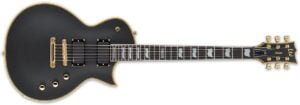
ESP LTD Deluxe EC-1000 vintage black is powerful and articulate! Thanks to the EMG humbucker pick-ups! This is one killer guitar! The EC-1000 is a monster in the sound department! It’s a mahogany body with a vintage black finish.
The neck is a thin U shape and is incredibly easy to play, and man is it fun! This model looks and sounds stunning! ESP has produced a home run, and I can’t recommend it enough! Bang for the buck is an understatement!
Features
- ESP warranty: 1 year.
- Mahogany body.
- 24 Frets.
- U-neck shape.
- EMG pickups.
Score
LTD EC-1000 Score
Overall
-
Build Quality
-
Playability
-
Sound
-
Appearance
Build Quality
ESP calls the body shape an Eclipse. But it’s pretty much a Les Paul with very small changes. Nice thing is that it only weighs 9 pounds! And it’s made from mahogany as well. The finish is flat black and looks great. Especially if you like hard rock and metal.
The neck feel good and is easy to fret. It’s pretty slim, so moving around is easy. I also enjoyed the quality of the hardware. It’s simple but effective. Overall, it’s good construction with some modern aesthetics.
Sound Performance
This guitar is raw, aggressive and brutal! If you’re into rock or metal, this is the sound for you. The pickups are high output and when used with the right amp, the sounds are killer! I appreciated the articulation and tight bass response.
If you are looking for a guitar that can chug, this is it. It can get pretty loose if you desire, but it’s easy to tame with the controls. Check out this video below to see what I mean about the aggressiveness of the guitar!
PROS
- Great build and hardware.
- Beautiful looking guitar.
- Easy to play neck and bonus cut-away.
- Incredible sound.
- Made by a known brand.
CONS
- Some complaints were high action until set up properly.
Schecter Hellraiser C-1

The Schecter Hellraiser C-1 is designed for modern guitarists! Its double-cutaway body gives you full access to the neck. And a push-pull coil tap pick-up design that will accommodate all types of tones!
The C-1 is a lot of guitar for the money! The Beautiful mahogany body and quilted maple top are brilliant. The neck is a treat to play, with low action and a great profile.
The EMG pickups give you a lot of articulate power and are ready to rock! This guitar can almost do anything. And it came well set up out of the box, you really need to look into this model!
Features
- Schecter’s warranty: 1 year.
- Rosewood Fingerboard.
- 24 Large Frets.
- C-neck shape.
- 25.5-inch scale length.
- EMG humbucker pickups.
Score
Hellraiser C-1 Score
Overall
-
Build Quality
-
Sounds
-
Playability
-
Versatility
Build Quality
I have always appreciated the build quality from Schecter. Even though their guitars are made overseas, they provide good quality. The body on this guitar is beautiful!
It’s detail and construction are perfect. Plus, the rounded profiles around the guitar make it comfortable to play.
The hardware is all pretty tough stuff, which includes solid tuners and a great tremolo bridge.
This guitar comes with a locking nut to ensure that proper use of the bridge won’t result in going out of tune. The wiring and hardware installation are all done well, and it’s quality work.
Playability
The neck on the C-1 is a thin C profile. It’s not ultra-thin, but fits my hand much better than thicker necks. This makes the playability feel faster as there is less material to hold onto. This is better for lead playing, but on this guitar, even chords are performed simply.
The guitar is comfortable, it sits in my lap without any balance issues. And when I’m standing, the guitar was easy to use on a strap.
I found it very easy to play, and having the full scale provided those extra notes that I like for leads.
PROS
- Quality build and hardware.
- Great sound.
- Plays great.
- Rock solid tuning.
- Made by a well known brand.
- Very versatile.
CONS
- Set up might be required for optimal performance.
- Lots of options may turn people off.
PRS SE Standard 245
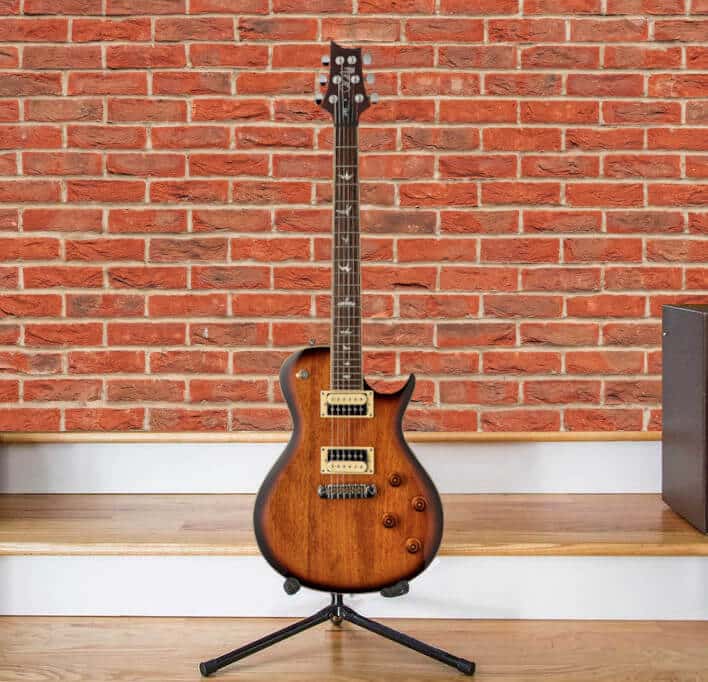
Features
- 22-fret mahogany neck with rosewood fretboard.
- PRS-designed tuners and tailpiece.
- PRS-designed SE 245 humbucker pickups.
- Volume and tone control for each pickup.
- Wide-fat neck profile.
Build Quality
The PRS SE Standard 245 is a well-built, sturdy guitar that is designed to last. I’ve played this model on numerous occasions, and I’m consistently impressed by its construction.
The mahogany body and neck give it a robust feel, while the rosewood fretboard adds a touch of elegance. With its solid hardware and overall attention to detail, this guitar is made to withstand the test of time.
Sound Performance
I found the SE Standard 245 to deliver a rich, warm sound. This is all thanks to its mahogany body and humbucker pickups. These pickups offer a wide range of tones, from deep lows to crisp highs, and are perfect for a variety of musical styles.
I could go from blues tones to aggressive metal and get exactly what I wanted. Keep in mind, your choice of amplifier will obviously play a big role here too.
The dual volume and tone controls allow for precise control over your sound, enabling you to dial in the perfect tone for any situation. Check out this video to hear it for yourself!
Playability
The wide-fat neck profile of the PRS SE Standard 245 is comfortable to play, making it suitable for players of all skill levels. I’ve found that this neck profile allows for a smooth, easy transition between chords and notes, enabling you to play with more fluidity.
Leads were no problem as the string spacing is just right for my hands. But if you like thin necks, this might not be for you.
It’s more of a vintage cut and plays that way too. The 22-fret design offers plenty of room for creative exploration, while the PRS-designed tuners ensure excellent tuning stability.
Cost and Value
Considering its features, build quality, and sound performance, the PRS SE Standard 245 is an excellent value for money.
Priced at $679.00, it offers an affordable entry point into the world of high-quality electric guitars. It’s a great investment for both beginners and experienced players seeking a reliable, versatile instrument.
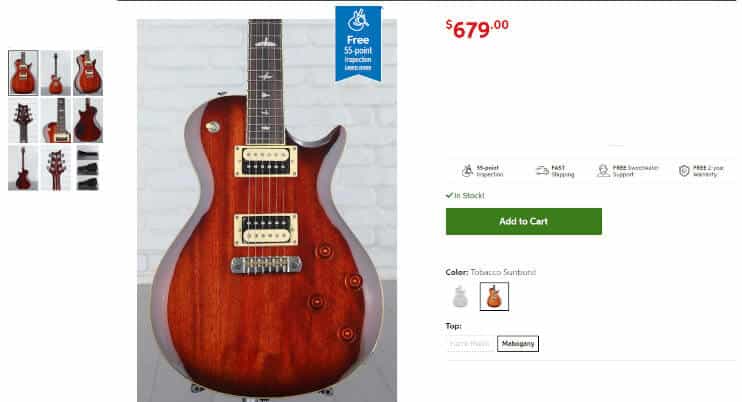
PROS
- High-quality construction and materials.
- Wide range of tonal options.
- Comfortable neck profile.
- Affordable price for a premium guitar.
- Reliable tuning stability.
CONS
- Wide-fat neck profile may not suit all players.
- No hard shell case included, only a gig bag.
Fender Deluxe Telecaster
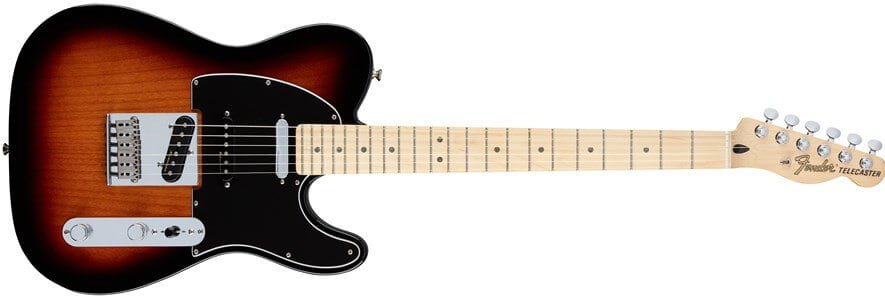
The Deluxe Nashville Telecaster delivers classic playability and feel! The vintage noiseless pickup delivers a telecaster tone without the hum! This is one amazing guitar!
Features
- Fender warranty: 2 year.
- Alder body.
- 22 Frets.
- Maple neck.
- Noiseless pickups.
- C style neck taper.
Score
| Assessment | Rating (1-5) |
|---|---|
| Build quality | 4 |
| Comfort | 4.1 |
| Playability | 4 |
| Aesthetics | 4.1 |
| Sound performance | 4.6 |
Build Quality
The Nashville telecaster has a serious vintage look, sound, and feel! This is because it’s built super well.
It has a gloss alder body, maple C-shaped neck, 25.5-inch scale length, and great-sounding pickups. You can also get it in a left-hand version as well as many colors. It’s a wonderful looking Telecaster!
The hardware is all quality parts. You can feel it as you use them. The knobs all feel very good, and the machine heads hold tune rigidly. I didn’t have to tune up very often between sessions.
Sound Performance
The sound quality has to be on the mark, though, especially for a telecaster. Now, there isn’t any magic to it, just the right pickups and body shape. But because this is a Fender guitar, they know how to do it right.
The pickups on this guitar are a bit different. There are three of them instead of two! This alone means more tone options than your standard Telecaster build.
I was getting some really tight, twangy tones from the middle pickup. But because it’s in the center, they also had a neat midrange tone to them!
It’s hard to explain, but this video below will show you what I mean. The sounds that are possible are demonstrated well. Have a listen!
PROS
- Quality build plus materials.
- Killer sound and tone.
- Plays and feels great.
- Looks beautiful and vintage.
- Experienced brand designed.
CONS
- Some complaints were high action until set up properly.
Epiphone SG Custom
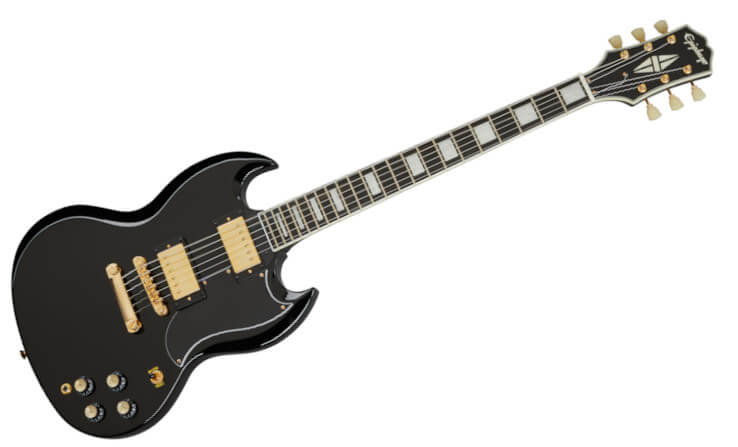
Features
- Solid mahogany body with gloss finish.
- SlimTaper D-shaped mahogany neck.
- Indian laurel fingerboard with block inlays.
- ProBucker 2 and 3 humbucker pickups.
- LockTone Tune-O-Matic bridge and stopbar tailpiece.
- Gold hardware and split-diamond headstock inlay.
Build Quality
The Epiphone SG Custom is a well-built guitar that showcases the quality craftsmanship one would expect from Epiphone. I’ve had the pleasure of playing this guitar on several occasions, and it never ceases to impress me with its durability and attention to detail.
The solid mahogany body and neck contribute to its overall sturdiness. While the laurel fingerboard adds a touch of elegance. Plus, it’s an SG, I mean it just screams rock and roll!
Sound Performance
This guitar is designed to produce the classic, powerful sound of an SG. In my experience, it delivers a rich, full tone with excellent sustain. It’s suitable for various genres, from metal to blues.
The ProBucker 2 and 3 humbuckers provide a broad range of tonal possibilities. Allowing you to achieve anything from warm, smooth tones to aggressive, high-gain sounds.
Playability
The SlimTaper D-shaped mahogany neck on the SG Custom makes it a pleasure to play. This neck profile caters to a wide range of hand sizes and playing styles, offering a comfortable grip and easy access to the upper frets.
The LockTone Tune-O-Matic bridge and stopbar tailpiece ensure stable tuning and precise intonation, making it a reliable choice for both live performances and studio sessions.
Cost and Value
Considering its features, build quality, and sound performance, the Epiphone SG Custom is a fantastic value for money. With a price tag set at $629.00, this guitar provides an affordable way to enjoy the legendary SG experience.
It’s an excellent option for beginners looking to upgrade their instrument or experienced players seeking a versatile and dependable guitar.
PROS
- Classic SG sound and aesthetics.
- Comfortable SlimTaper D-shaped neck.
- Wide range of tonal options.
- Solid build quality.
- Good value for money.
CONS
- Some players might not like the look.
- Hard shell case and gig bag sold separately.
Fender Deluxe Stratocaster
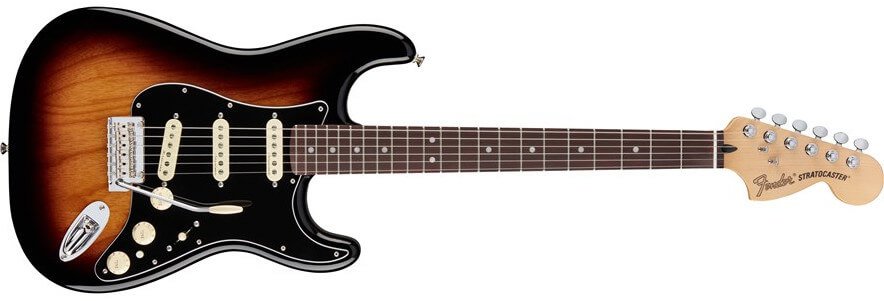
This solid body Stratocaster gives you popular features at a price that is unheard of! For a Fender-made guitar, this is the Stratocaster you need to get for your playing adventures!
Features
- Fender warranty: 2 year.
- Alder body.
- 22 Frets.
- Pau Ferro Fretboard.
- Noiseless single coil pickups.
- C style neck taper.
Score
| Assessment | Rating (1-5) |
|---|---|
| Build quality | 4 |
| Comfort | 4.4 |
| Playability | 4 |
| Aesthetics | 4.1 |
| Sound performance | 4.4 |
Build Quality
This beautiful vintage guitar has an ash body with a high gloss polyester finish. It also has a C-style maple neck with a 25.5-inch scale length and vintage-style single coil pick-ups. I inspected the soldering for the electronics and was surprised to find such good work.
This guitar is also available in different colors or finishes. A left-handed model also exists. There is serious bang for your buck in this strat, those that own one love it!
The machine heads and bridge are of good quality. This is a Fender guitar, after all. They are made in Mexico and so the quality is very good!
Sound
The first thing that is apparent is the noiseless pickups. I do love the sound of single-coil pickups, but not the noise.
These, however, are a great-sounding pickup! The chimey Stratocaster tone is all here. You get the bright twangy tone at the bridge and warmer sounds as you move toward the neck.
The tone is very bright and clear, just as you would expect and hope for. Especially from a Stratocaster. This is, after all, what they are known for, and this model does that very well. This video will demonstrate that very well. I was getting tones just like this.
PROS
- Build quality.
- Sound performance.
- Feel and ease to play.
- Great hardware.
- Colors and options available.
CONS
- May need a good set up.
What To Look for When Choosing an Electric Guitar
If you are not sure which guitar might fit you best, then there are a few things to think about. Here are some key factors to consider when selecting an electric guitar as a beginner.
1. Pickups
Pickups play a crucial role in shaping the sound of your electric guitar. There are two main types of pickups: single-coil and humbucker. Single-coil pickups produce a bright, clear sound with a noticeable twang, ideal for styles like country and surf rock.
Humbuckers, on the other hand, offer a thicker, warmer sound with more output, making them suitable for heavier styles like rock and metal. Consider which type of pickups best match your desired tone.
2. Neck Profile and Scale Length
The shape and size of the guitar’s neck can significantly impact playability. Common profiles include C-shaped, D-shaped, and V-shaped necks, each offering a different feel. Choose a neck profile that feels comfortable and allows you to play with ease.
Additionally, consider the guitar’s scale length, which affects both the tension of the strings and the spacing between frets.
A shorter scale length typically results in lower string tension and closer fret spacing. This makes it more comfortable for players with smaller hands or those who prefer a slinkier feel.
3. Hardware
Pay attention to the hardware on the guitar, such as the bridge, tuners, and controls. High-quality hardware will help ensure that your guitar stays in tune and functions properly.
Look for features like locking tuners for better tuning stability, adjustable bridges for precise intonation, and smooth control knobs for accurate adjustments.
4. Aesthetics
While the look of a guitar might not be the most critical factor in your decision, it’s still essential to choose an instrument that visually appeals to you. Pick a guitar with a color, finish, and design that you find attractive and inspiring.
5. Playability and Comfort
Finally, the most important thing is to select a guitar that feels comfortable to play and suits your individual preferences. If possible, try out different guitars in person to get a sense of how they feel in your hands and how they respond to your playing style.
By considering these factors and weighing your options, you can find the perfect electric guitar that meets your needs and helps you achieve your musical goals.
6. Additional Equipment
The electric guitar works its best with an amplifier. So that might also be something to consider when looking for your first model. While an electric guitar can produce a bit of volume on its own, it’s better with an amplifier.
Conclusion
The overall quality in relation to price is going to be the bottom line in an electric guitar under $1000. Buying a new instrument is an awesome experience.
Especially if you have never owned one before. So make sure to spend time doing some research before making the decision.

